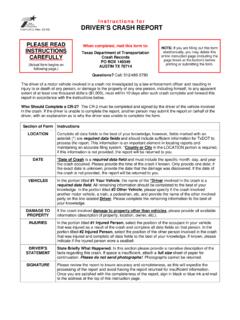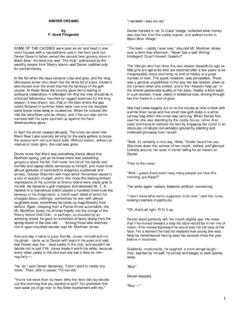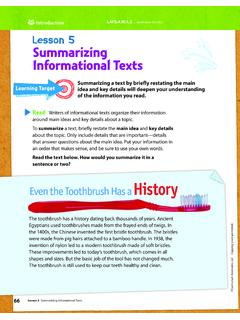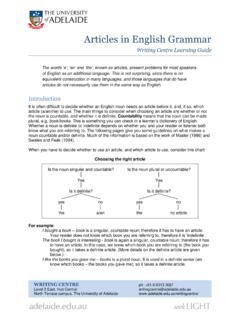Transcription of THE SCIENTIFIC METHOD: STEPS & EXAMPLES EXAMPLE …
1 THE SCIENTIFIC METHOD: STEPS & EXAMPLESA nyone can think like a scientist by using common sense and paying attention to SIX careful State the Problem or Question to be answered 2. Make some related Observations 3. Form a Hypothesis 4. Test the Hypothesis (figure out a way to get some evidence) 5. Get some Results6. Make a ConclusionThe best way to understand this is to look at some #1: CINDERELLAThe Prince in the fairy tale Cinderella was very SCIENTIFIC in his approach to figuring out who Cinderella was. (If you don't know the story of Cinderella, well, that's pretty sad. Go ask someone.)1. State the Problem or Question to be Prince asks himself "Which girl in my kingdom is Cinderella?"2. Make some related Prince observed that Cinderella wore glass slippers at the dance, and he also notices a glass slipper left behind after the dance (after Cinderella had run away near the stroke of midnight).
2 3. Form a hypothesis is an explanation for your question or problem ( step 1) that can be tested using evidence. Important: a hypothesis must be testable in other words, there must be a way to prove that it is either right or wrong based on evidence. The Prince says: Cinderella will be the one girl in my kingdom whose foot fits the slipper. (OK, technically there could be other girls who have the same size foot as Cinderella. But this is a fairy tale so let s assume that only Cinderella's foot will fit the slipper!)4. Test the Prince tries the slipper on all the girls in his Get some turns out the slipper fits only one person in the whole Kingdom the lowly servant girl. (Who would have thought?)6. Make a Prince concludes that the servant girl is Cinderella! They are married and live happily ever The Prince would probably have made an excellent scientist.
3 Notice that the Test of his Hypothesis produced an unexpected Result ( he never expected that the servant girl would have been Cinderella). The Prince accepted the Conclusion that logically followed from the Result in spite of the fact that it was unexpected. In science, EVIDENCE RULES. SCIENTIFIC evidence sometimes points to conclusions that some people don t like for personal reasons. EXAMPLE : there is a vast amount of evidence that life has evolved over geologic time. Many people find the concept of biological evolution wonderful and fascinating, and accept the evidence that it is true. A few people find the concept repugnant and reject it. But those personal feelings don t change the facts and the evidence that evolution is #2: KELPLet s now look at an EXAMPLE that is closer to how an oceanographer might work.
4 The EXAMPLE concerns kelp, a large alga that lives attached to the bottom in shallow water along the west coast of North America, including right off our own coast in San Diego State the Problem or Question to be controls where Giant Kelp (Macrocystis pyrifera) lives in the oceans?2. Make some related go out in a boat around the San Diego shoreline, and notice that kelp grows only in in water shallower than about a hundred Form a might this be? Let s look at some facts we already know to guide us in forming a hypothesis. How about light? Giant Kelp is a macro-algae that needs sunlight to photosynthesize. Sunlight penetrates only into the upper few hundred feet of the ocean, and kelp does not live below this depth. Maybe there is a connection here. If we can figure out how kelp responds to varying levels of sunlight, we can determine if sunlight is an important control on where kelp can live.
5 Note that this is only one of several different hypotheses we could propose about why kelp lives only in shallow water. Perhaps kelp needs to be washed by frequent wave action, and so needs to be in shallow water. Perhaps kelp needs certain chemical elements that occur only in shallow water. These are all good hypotheses, but it s best to test only one at a time, and choose the one you think is most our hypothesis is: Giant Kelp needs sunlight at least equal to that found at 100 feet to live. 4. Test the two experimental tanks, I place two groups of kelp. The kelp plants in one tank get sunlight at the intensity found at 20 feet below the surface of the ocean. The group in the other tank only gets light with the intensity found at 120 feet. Otherwise, the two tanks have identical properties.
6 (This is important. I must allow only one factor in this case the amount of sunlight to vary between the two tanks. If I change more than one factor at a time, I won't know for certain what factor is responsible for any differences that I might observe.) The experiment goes on for several Get some kelp that gets the shallow ocean sunlight lives; the kelp that gets only the dim deep ocean sunlight eventually Make a intensity of sunlight is an important control on where kelp lives in the ocean. Kelp can live only in areas with abundant sunlight. That must be at least one of the reasons why kelp lives only in shallow water. Note that there could be other factors that determine where kelp lives. If we continue observing, we ll note that kelp doesn t grow everywhere that water is less than 100 feet deep, so there must be other things that make an area a good habitat for kelp forests.
7 Science is an ongoing process of forming and testing hypotheses!







